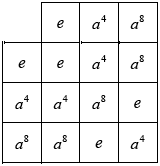| Date | November 2013 | Marks available | 2 | Reference code | 13N.3srg.hl.TZ0.2 |
| Level | HL only | Paper | Paper 3 Sets, relations and groups | Time zone | TZ0 |
| Command term | State | Question number | 2 | Adapted from | N/A |
Question
Let \(G\) be a group of order 12 with identity element e.
Let \(a \in G\) such that \({a^6} \ne e\) and \({a^4} \ne e\).
(i) Prove that \(G\) is cyclic and state two of its generators.
(ii) Let \(H\) be the subgroup generated by \({a^4}\). Construct a Cayley table for \(H\).
State, with a reason, whether or not it is necessary that a group is cyclic given that all its proper subgroups are cyclic.
Markscheme
(i) the order of \(a\) is a divisor of the order of \(G\) (M1)
since the order of \(G\) is 12, the order of \(a\) must be 1, 2, 3, 4, 6 or 12 A1
the order cannot be 1, 2, 3 or 6, since \({a^6} \ne e\) R1
the order cannot be 4, since \({a^4} \ne e\) R1
so the order of \(a\) must be 12
therefore, \(a\) is a generator of \(G\), which must therefore be cyclic R1
another generator is eg \({a^{ - 1}},{\text{ }}{a^5},{\text{ }} \ldots \) A1
[6 marks]
(ii) \(H = \{ e,{\text{ }}{a^4},{\text{ }}{a^8}\} \) (A1)
 M1A1
M1A1
[3 marks]
no A1
eg the group of symmetries of a triangle \({S_3}\) is not cyclic but all its (proper) subgroups are cyclic
eg the Klein four-group is not cyclic but all its (proper) subgroups are cyclic R1
[2 marks]
Examiners report
In part (a), many candidates could not provide a logical sequence of steps to show that \(G\) is cyclic. In particular, although they correctly quoted Lagrange’s theorem, they did not always consider all the orders of a, i.e., all the factors of 12, omitting in particular 1 as a factor. Some candidates did not state the second generator, in particular \({a^{ - 1}}\). Very few candidates were successful in finding the required subgroup, although they were obviously familiar with setting up a Cayley table.

